By John Brown
A little over five centuries ago, a guru named Nanak founded a new faith among the Hindu communities that farmed the rich agricultural areas of northern India known as the Punjab, the Land of the Five Rivers. The new faith blended aspects of Hindu compassion and Islamic brotherhood; preached equality among all human beings; rejected varna, the Hindu system of caste; and banned suttee, the burning of a dead man’s wife on his funeral pyre. Nanak called his faith “Sikhism” after “Sikh,” which evolved from the Sanskrit word shishya, meaning disciple or devoted follower. Soon Muslims and others began converting to the faith.
For three centuries the Sikhs withstood persecution, violence, and atrocities, fighting many battles against Mughal rulers, Afghan invaders, rajas of neighboring hill states, and Brahmins, the elite in the caste system who considered the Sikh principle of equality an assault on their position of privilege. To defend themselves, the Sikhs sent far and wide for the finest horses and weapons and introduced intensive training in swordsmanship, archery, and physical endurance. This training became an integral part of the Sikh ideal, as skill in combat was necessary if the religion was to be saved from those wanting to destroy it. The Sikhs brought to their battles, it was said, “a raw courage, a powerful sense of kinship, and an absolute commitment to the religious ideals enunciated by the Gurus, for which they were willing to sacrifice their lives.”
The Khalsa Brotherhood
In 1699, Gobind Singh, the 10th and last guru of Sikhism, baptized Sikhs into a brotherhood he called Khalsa, or “pure ones.” At least 50,000 were baptized in the first few days and given the surname Singh, or Lion. The baptism ceremony signified the birth of a new martial race.
The Khalsa was largely a self-defense brotherhood. It developed into a confederacy of 10 misls, or groupings, each led by a chief with absolute power over the territory and soldiers he ruled. These misls would combine in times of war to face a common enemy. They were, in effect, the army of the Sikhs.
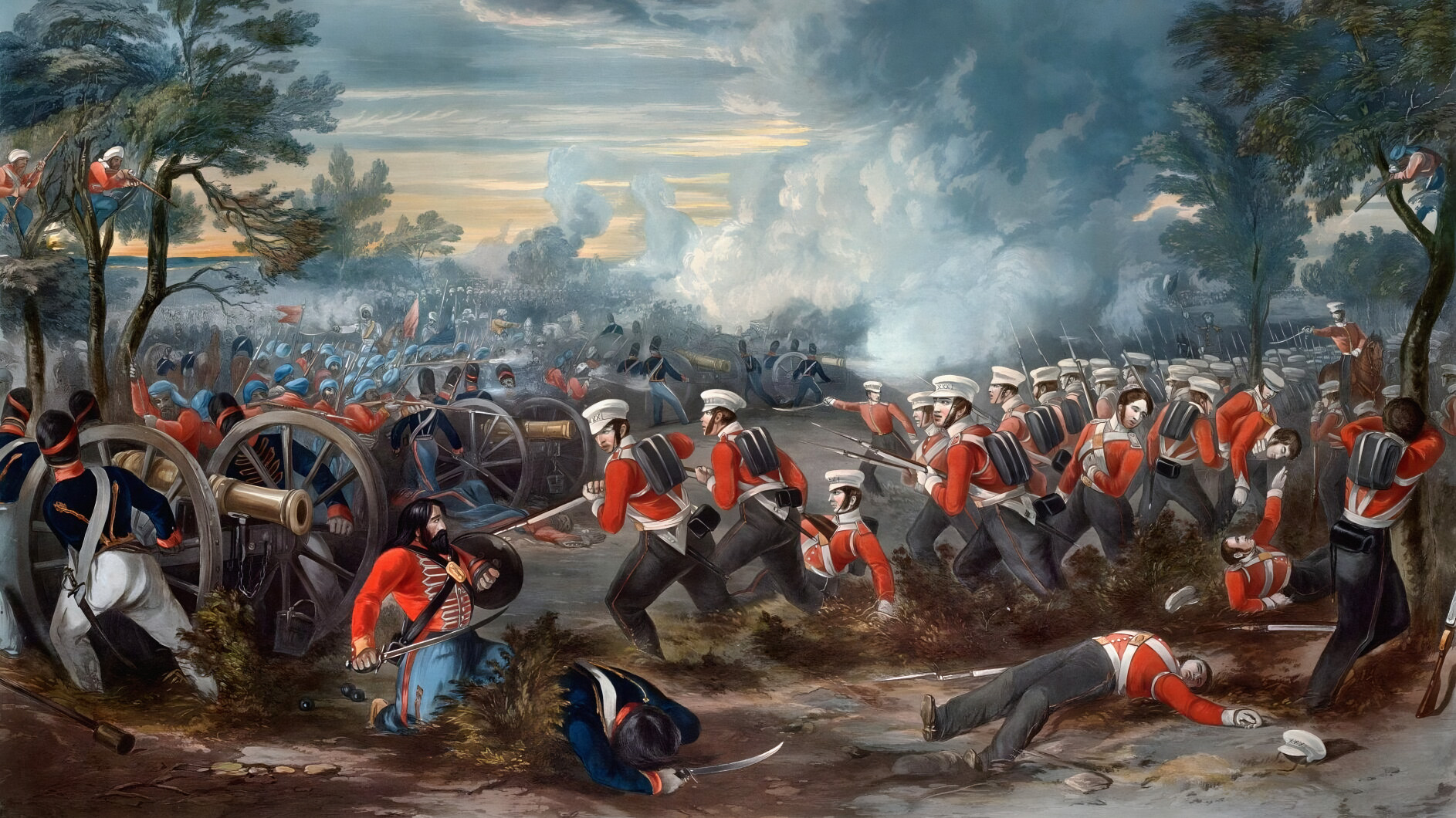
Throughout the 1700s, the Khalsa continued fighting battles against the rajas of the hill states, Mughal rulers, and others, and toward the end of the century it had driven out the Afghans, who had invaded and settled in large areas of the Punjab. With control over most of the Punjab, the Sikhs declared sovereignty over all of it. In 1799 a one-eyed, hard-fighting, hard-drinking general of one of the misls, Ranjit Singh, made himself the undisputed leader of all the misls. He established a power base around the two cities of Lahore and Amritsar and, by subjugating other chiefs and weaker neighbors by force or craft, gained sovereignty over all the Punjab, assuming the title of maharaja with his darbar (court) at Lahore.
Ranjit Singh Raises a Modern Army
Ranjit, illiterate, inquisitive, and above all pragmatic, had 20 wives and a colorful harem of nubile women and graceful painted boys. He was often drunk (his favorite drink was a cocktail of brandy, opium, meat juices, sauces, spices, and powdered pearls) and enjoyed riding around Lahore on the back of an elephant in the company of a ravishing harlot. He was a master horseman and swordsman, a veteran of many battles, and he built the Khalsa into a powerful army. But contact with the British East India Company and its Bengal Army led him to realize that the Khalsa, powerful as it was, required modern arms and training. He set about modeling it on European lines.
With the ending of the Napoleonic Wars, there were large numbers of experienced military officers available for hire as mercenaries, and Ranjit hired more than 200 of them, ranging from gunnery corporals to generals. They organized, armed, and trained the Khalsa infantry, including Hindu Dogras, Rajputs, Baluchis, and Gurkhas, along British lines. They also built a factory at Lahore that produced excellent small arms and cannons of all sizes. The Khalsa artillery, with more than 400 pieces ranging from 48-pounder siege guns drawn by elephants to three-pounder swivel guns carried by camels, was officered by Sikhs, with the gun crews composed almost entirely of Punjabi Muslims. The guns were noted for accuracy and high rates of fire. The regular cavalry never reached a standard comparable with the infantry, and neither did the more numerous irregular cavalries, or gorchurras, which were raised by land-owning knights who led them into battle in chain mail and shining armor. They were masters of the hit-and-run and ambush, but in set-piece battles they were no match for the Bengal Army’s disciplined cavalry brigades. In all, the Khalsa numbered about 75,000 men.
Instability in the Punjab
When Ranjit died of a stroke in June 1839, drunkenly magnificent to the last, the Sikh nation he had built up with such skill over 40 years began to unravel. Fratricide among his natural heirs left his five-year-old son, Dalip Singh, with Dalip’s mother, Rani Jind Kaur, as regent, to succeed him as maharaja in a court in which a number of factions jockeyed for power in the Punjab. Sikhs, who lorded it over the Hindus and Muslims, accounted for only 7 percent of the population of about 22 million, with Muslims accounting for just over 50 percent and Hindus a little less than 42 percent. It was one of Rangit’s great achievements that he had expanded the Punjab and held it together as a nation for many years.
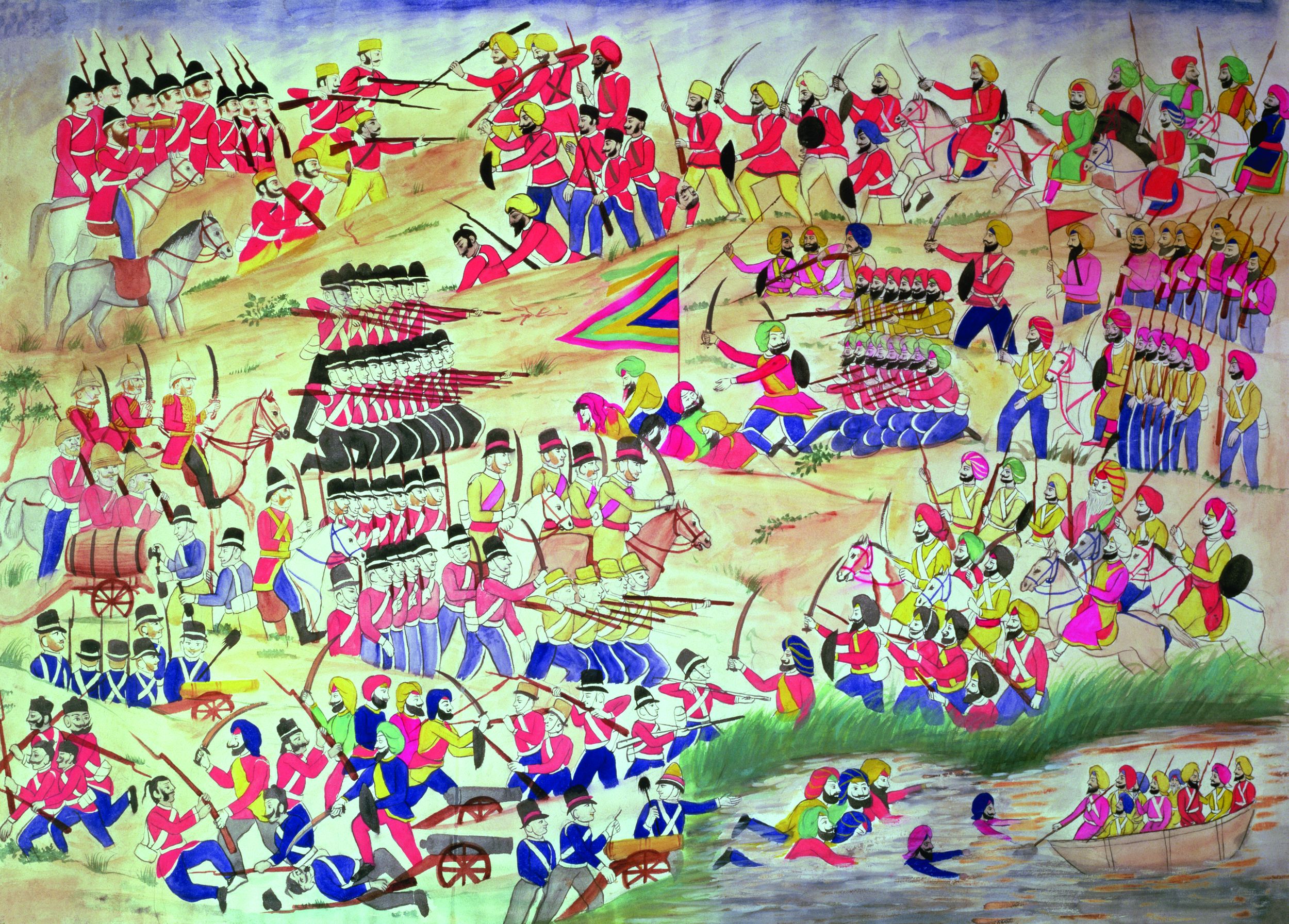
During the reign of Ranjit Singh, the soldiers of the Khalsa considered British soldiers to be fellow warriors and held them in the highest regard. While their regard for Indian soldiers of the East India Company was not as high, they still believed the Anglo-Indian armies to be quite formidable. But in 1842 the Khalsa’s opinion changed when the British were forced out of Afghanistan and refugees from Kabul, some 4,500 soldiers and 12,000 civilians, were massacred in the Khyber Pass. For the Khalsa it posed a question: if the Sikhs could beat their former Afghan overlords and keep the northwestern frontier tribes in check, how could the British have been so easily defeated by the Afghans?
While the Khalsa’s regard for British soldiers was only slightly diminished, it began to regard the East India Company’s native troops with contempt, and many among the Khalsa looked forward to testing themselves against the Bengal Army. Some at the Sikh court encouraged the Khalsa in the hope that it would cut the Bengal Army down to size. The British and Sikh powers were about to collide.
While the Punjab drifted into anarchy, no military or political figure emerged to lead the Khalsa. The soldiers therefore created their own command structure, with each battalion electing five representatives who formed a governing committee. The governing committee, however, concerned itself primarily with ensuring that the Khalsa was paid. Still, for the people of the Punjab, the Khalsa was the champion of the Sikh community. It was a blend of the Praetorian Guard and the New Model Army.
Sir Hugh Gough’s Faith in “Cold Steel”
Lieutenant General Sir Henry Hardinge took over as governor-general of India in September 1844. He had a varied military background: he had campaigned in the Peninsular War, in which he was twice wounded, losing a hand, and had served as deputy quartermaster general of the Portuguese Army. During the Waterloo campaign, he was again badly wounded. Hardinge was active in British politics, serving as the Duke of Wellington’s secretary for war before being sent to India as governor-general. Upon his arrival in India, Hardinge was quickly caught up in the problem of dealing with the Punjab, particularly the Khalsa, which he later described as Britain’s “bravest and most warlike and most disruptive enemy in Asia.”
The commander in chief of the army was Lt. Gen. Sir Hugh Gough, a 66-year-old Anglo-Irishman who had made his name in the Opium Wars. The gallant old campaigner had been commissioned into the army at age 14, had fought engagements as far afield as Surinam and Nanking, and had led his regiment from Talavera to Vittoria in the Peninsular War. He had fought under Wellington but had learned little from him. He believed that “cold steel”—the bayonet, saber, and lance—solved all tactical problems. “He is brave as a lion but has no headpiece,” one of his officers said of Gough. Others commented, only partly in jest, that his vocabulary was restricted to the word “Charge” and a few other words such as “At ‘em wi’ the bayonet, lads.” But he was popular with the rank and file, who nicknamed him “Tipperary Joe,” and he was always to be seen in the thick of battle in his long, white “fighting coat” visible to both friend and foe.
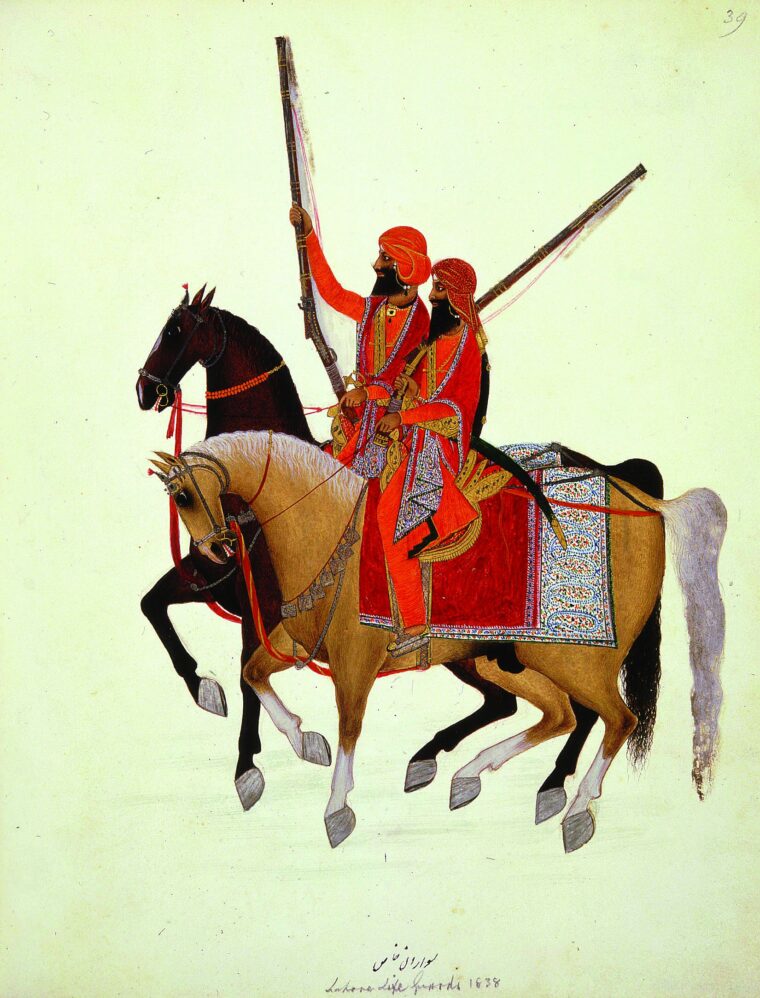
Major George Broadfoot, the political agent at Ludhiana, was known for his hostility toward the Sikhs. Aware of the Khalsa’s antipathy to the British, he took several provocative actions aimed at goading the Khalsa into precipitating a confrontation with the British. One was to pronounce Sikh possessions south of the Sutlej to be under British protection and declare that they would revert to the British in the event of Dalip Singh’s death. Broadfoot’s actions, combined with British troop movements south of the Sutlej, left the Khalsa with little doubt as to British intentions for the region.
War Declared
By November 1845, two conspirators, both Brahmins, had emerged from among the factions at the Lahore darbar and taken power. Lal Singh became prime minister and Tej Singh assumed the post of commander in chief of the army. The pair formed a triumvirate with the sexually debauched regent, Rani Jind Kaur, to rule the Punjab. But they ruled in name only—the real power in the land remained with the Khalsa. During September 1845, spies in Lahore reported to the British that talk in the Khalsa was about mounting a raid into British territory south of the Sutlej. The regent, it was said, was giving the raid every encouragement in order to get the soldiers away from Lahore. Upon hearing this, Hardinge immediately dispatched an additional 5,000 troops to the region south of the Sutlej and set off from Calcutta with his entourage to join them.
On December 11, some 50,000 Khalsa under the command of experienced generals Tej Singh and Lal Singh crossed the Sutlej into British territory. This was an open infraction of the 1809 Anglo-Punjabi treaty that cited the Sutlej as the division between Sikh and British spheres of influence, and the governor-general declared war on the Lahore government the next day. About 20,000 of the Khalsa, led by Tej Singh, took up positions close to Maj. Gen. Sir John Littler and his division in the cantonment at Ferozepore, but they did not attack the small, nearly defenseless garrison. A few days later, about 30,000 Khalsa troops led by Lal Singh crossed the Sutlej and moved into place at the nearby village of Ferozeshah.
The British Army of the Sutlej was widely dispersed in the region. A division of six Indian infantry regiments, two Indian cavalry regiments, the 62nd Foot, and some artillery, about 7,000 in all, was at Ferozepore. At Ludhiana, about 80 miles from Ferozepore, were five Indian infantry regiments, an Indian cavalry regiment, and the 50th Foot, about 5,000 in all. And at Ambala, 80 miles from Ludhiana and 160 from Ferozepore, was the remainder of the army, numbering about 10,000 men. Gough was with the troops at Ambala when he heard the news that the Khalsa had crossed the Sutlej and taken up positions at Ferozepore and Ferozeshah. He ordered an immediate march on the enemy forces.
It was a grueling 150-mile forced march along roads of heavy sand, through scrub and thorn bush, with water scarce, no bread, and halts so brief that there was no time to cook the meat ration. The dust was appalling. Days were hot, nights bitterly cold, and the troops had no heavy clothing or blankets. Nevertheless, they linked up with the Ludhiana garrison and reached the village of Mudki, 20 miles from Ferozepore and about 12 miles from Ferozeshah, at noon on December 18. Many of the troops instantly fell down, exhausted or asleep. Gough decided to make camp for the night.
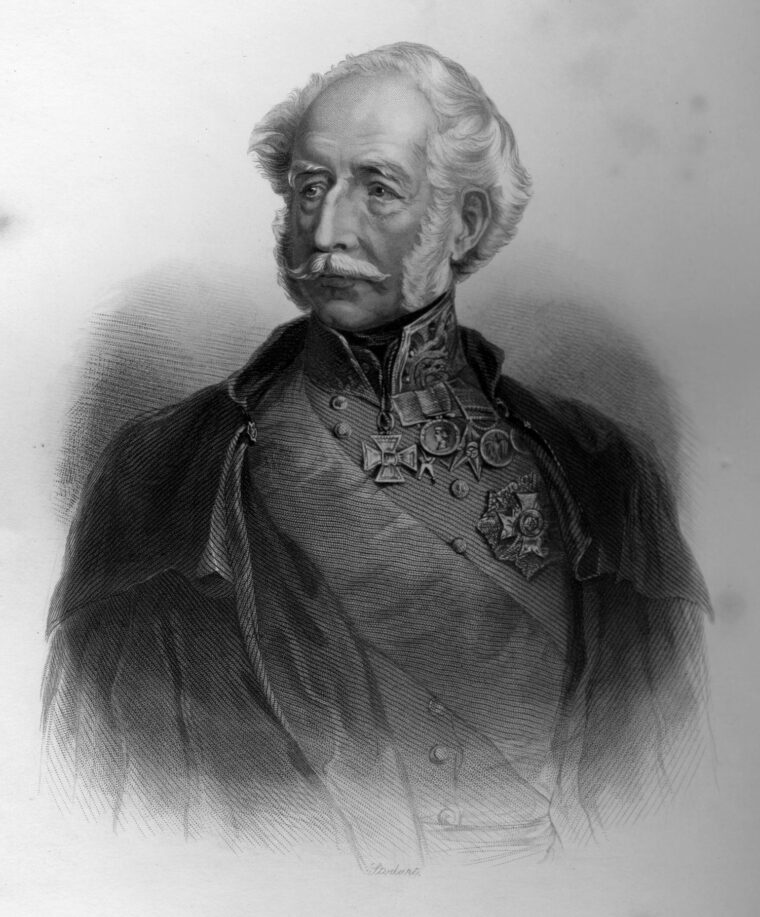
“Midnight Mudki”
Three hours after their arrival at Mudki, reports came in that a detachment of the Khalsa—some 15,000 cavalry and 5,000 infantry—was moving on Mudki from Ferozeshah. Gough immediately unleashed his cavalry. The 4th Light Cavalry and 9th Irregular hit the Khalsa cavalry on the right flank, while the 3rd Light Dragoons swept around the Khalsa left flank, driving into them and putting some of their guns out of action. As the sun was going down, Gough ordered in the infantry.
The Khalsa infantry and its guns were in thick scrub and jungle. The Anglo-Bengali infantry advanced into the jungle as darkness fell and a vicious hand-to-hand battle began in dust and dark. No quarter was asked or given; it was slaughter on both sides, bayonet against tulwar. The Khalsa fought with fanatical courage, but by midnight they had been forced to fall back to Ferozeshah. Behind them they left 17 guns. The victorious British dubbed the battle “Midnight Mudki.”
Gough had been in the thick of the confused fighting; he did not leave the field until 2 am. At dawn he was ready to go again, but his troops were so exhausted and disorganized that an immediate attack on the Khalsa at Ferozeshah was out of the question. The next two days, December 19 and 20, were taken up with rest, care of the wounded, burial of the dead, reorganization, and scouting by staff officers of the Kalsa position. Gough reorganized his army, totaling 16,700 troops (6,000 of them British) and 69 guns, into four divisions—the 1st commanded by Maj. Gen. Sir Harry Smith, the 2nd by Maj. Gen. Walter Raleigh Gilbert, the 3rd by Brig. Gen. William Wallace, and the 4th by Littler at Ferozepore. During the night of December 20, Gough sent a message to Littler ordering him to leave a small garrison at Ferozepore and bring his division to Ferozeshah to join the main army.
“I Promise You a Splendid Victory”
At 4 am on December 21, the Army of the Sutlej moved out from Mudki for Ferozeshah. They arrived in front of the Khalsa position at 10 am, when the troops were allowed a cold breakfast. Lal Singh’s Khalsa position was roughly a mile square around the village of Ferozeshah. It was ringed with trenches and field fortifications on a line of hillocks, with guns emplaced among the mounds and ditches. Fifteen thousand regulars and the same number of militia, with 102 guns, were packed into the position. On three sides of the position patches of jungle would hinder an attack, but on the eastern side, facing the British, it was flat maidan (plain). Gough intended, as soon as his troops finished breakfast, to launch a headlong charge across the maidan and into the Khalsa position. “I promise you,” he told Hardinge, “a splendid victory.”
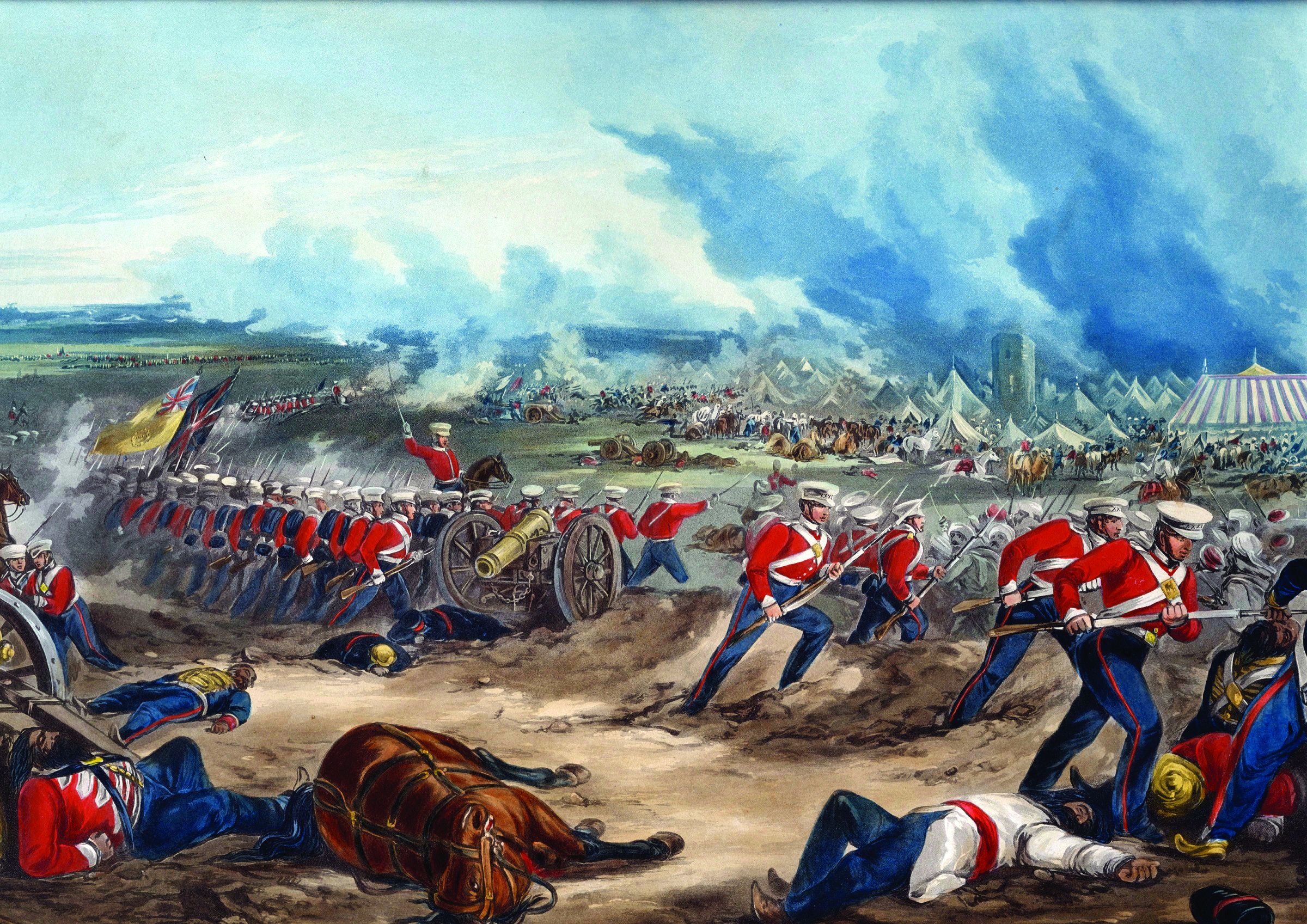
To Gough’s astonishment, Hardinge told him he must wait for Littler. “With the Sikhs having a two to one advantage in men and guns and are in cover,” Hardinge said, “an attack on them without the support of Littler’s division is too much a risk.” Gough argued that this was the shortest day of the year and that waiting for Littler would force his troops to fight again in darkness and chaos as they had at Mudki. Hardinge was adamant—wait for Littler.
Littler arrived at 1:30 in the afternoon, and Hardinge told Gough, “Now the army is at your disposal.” Another two hours were taken up before Gough had the army formed up and ready to fight. Gilbert’s 2nd Division was on the right; next to him were the massed guns under Brooke. Wallace’s 3rd Division was in the center, and Littler’s 4th Division was on the left. Smith’s 1st Division was in reserve. British cavalry was on the flanks. Deployment was not complete until 3:30 pm, leaving only two hours of daylight for the battle.
The Battle of Ferozeshah Begins
Artillery on both sides opened fire, and the British immediately found themselves outgunned in both numbers and firepower. The British guns were quickly moved forward, and Littler began to advance ahead of the rest of the army. Littler’s Bengalis and the 62nd Foot, hungry and footsore as they were after their march from Ferozepore, closed to within 150 yards of the Khalsa entrenchments in the face of savage fire. They were about to launch a final charge when they were blasted with a hail of grapeshot. Seven officers and 97 men fell dead and another 200 were wounded. Seeing this happen to the British regiment, the Bengali regiments collapsed. Littler had to pull them back to reorganize.
On the right, where Gough had placed himself, the 29th Foot and 80th Foot charged forward in the face of murderous fire, crossed the entrenchments, captured the guns on their front, and broke through into the Khalsa camp. There, a group of Akalis (fanatical ascetics known as the Children of God the Immortal) in chain armor fought with great valor until British bayonets killed them all. The Sikh gunners, wielding tulwars, fought to the last man.
In the center, the 3rd Division met with such devastating fire that their left fell back. But Smith threw in a brigade from the reserve and restored the situation. The 50th Foot was attacked by the pride of the Khalsa, Italian General Paolo Avitabile’s four battalions. The 50th beat them back in a hand-to-hand fight and captured their guns. Smith now charged with his reserve division and, joined by troops who had lost contact with their own units, burst into Ferozeshah. The Khalsa refused to surrender; they fought until they were slaughtered.
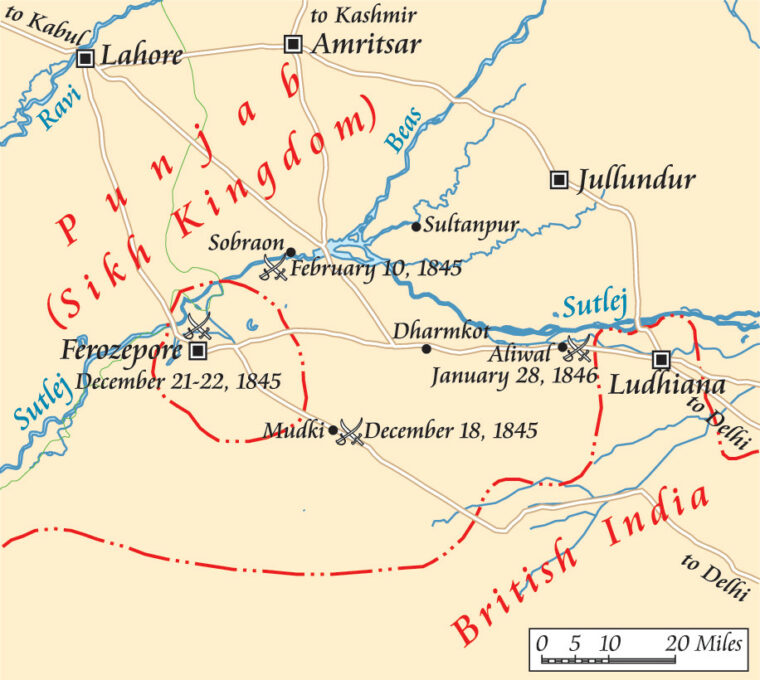
The British Give Up Costly Ground
As night was falling, the 3rd Light Dragoons charged through the center of the Khalsa position, creating more havoc. Then a huge explosion lit up the position as a Khalsa powder magazine went up in flames. Fires quickly spread, setting off more explosions as the flames reached stocks of powder and ammunition. Many on both sides were killed or injured in the explosions. Smith pushed on to an area of the Khalsa camp about half a mile to the north of the village. There he rallied many soldiers who had lost contact with their units in a semicircle on the 50th Foot. He now had about 3,000 troops in all.
When the moon rose just after midnight, Smith’s isolated force was revealed to the Khalsa, who closed in and opened fire on them. Casualties were heavy among the British troops, including many who were killed or wounded without waking up while they slept an exhausted sleep. His losses mounting, Smith decided that he could not hold the position. He made a feint attack and fought his way out under cover of the smoke and dust. Guided by the dead from his original line of advance, Smith brought his force safely to the rear.
During the cold night, Gough decided to reform his mixed-up divisions and retire. All units withdrew from Ferozeshah, picking up the wounded and returning to their original positions before the attack. Despite their heavy losses, the Khalsa immediately reoccupied the entrenchments the Anglo-Bengalis had taken at fearful cost and opened fire again. The night of December 21 was one of gloom for the British soldiers, who were close to annihilation. The Sikhs had practically recovered the whole of their entrenched camp; exhausted and decimated British divisions bivouacked without cohesion over a wide area. The situation was so critical that Hardinge packed up his papers and valuables for dispatch to the rear, including a sword that had belonged to Napoleon and had been given to him by Wellington at Waterloo.
Throwing Men at the Khalsa Lines
At daybreak Gough lined up his forces for another assault on Ferozeshah. His infantry, in the center, was supported by heavy guns and a rocket battery and on both flanks by horse artillery and cavalry. Gough placed himself at the head of the right of the line, with Hardinge at the head of the left. The British artillery opened fire and the army lunged forward.
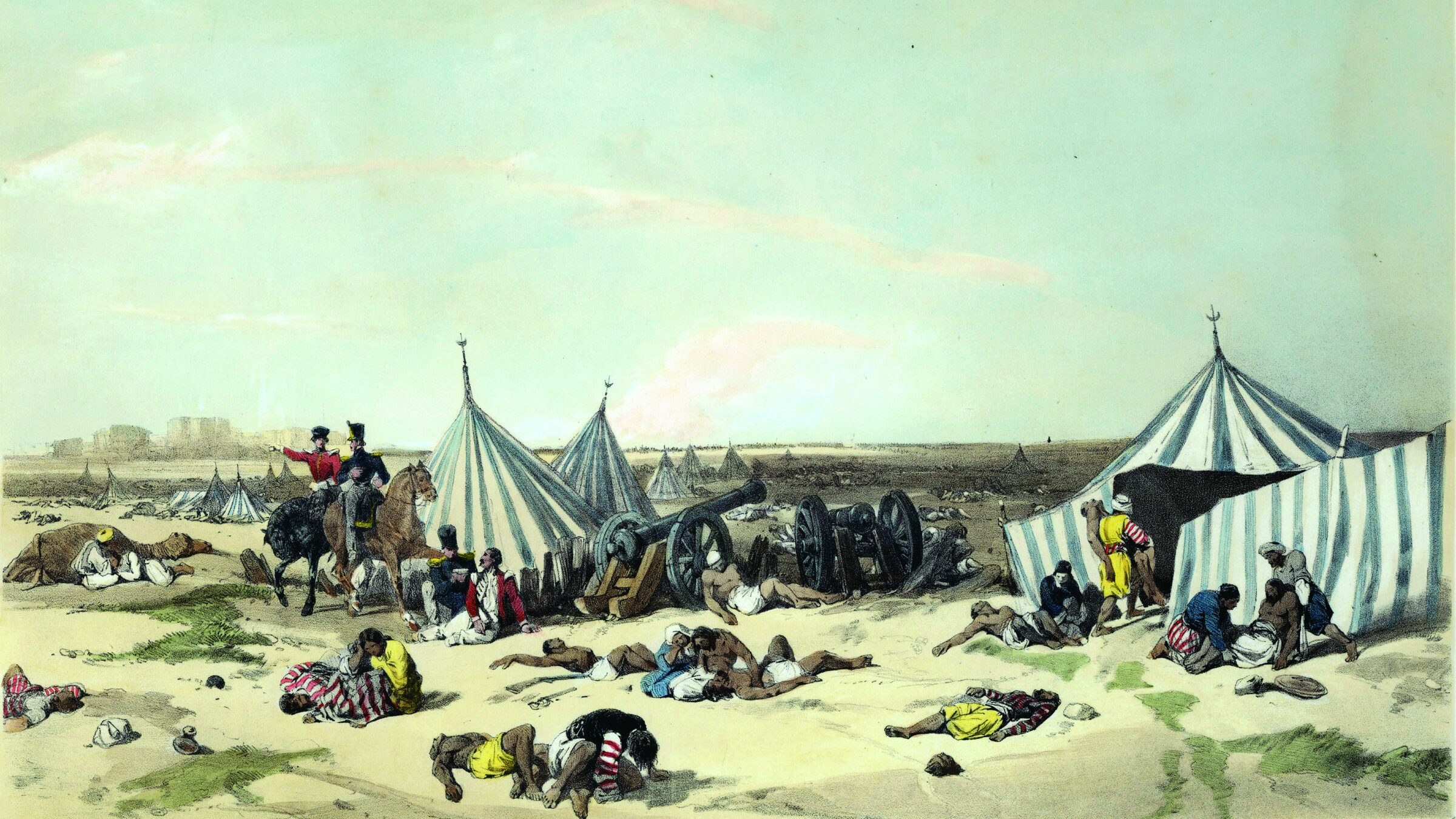
British and Bengali soldiers moved forward in ragged lines, with the horse guns thundering ahead of them. Khalsa gunners battered them and picked off the ammunition wagons. Undaunted, the British forces fought their way into Ferozeshah, driving the Khalsa before them and sweeping irresistibly through the Khalsa camp, bayoneting all enemies in their path. At the far end of the camp the attack halted and the troops, displaying captured Khalsa standards, presented arms and cheered as Gough and Hardinge rode along the ranks.
The ferocity of the fighting became the stuff of legend. Captain Joseph Cunningham, an East India Company political agent, wrote that “guns were dismounted and their ammunition was blown into the air. Squadrons were checked in mid career. Battalion after battalion was hurled back with shattered ranks. The obstinacy of the contest threw the English into confusion. Men of all regiments and arms were mixed together. Generals were doubtful of their own success, and colonels knew not what had become of the regiments they commanded or of the army of which they formed a part.” But they had taken Ferozeshah and captured 73 cannons and a huge booty of ammunition, cattle, and grain. The troops were so parched with thirst that they drank from wells choked with enemy corpses and from earthenware pots of water the Khalsa had used for washing wounds. Many were so exhausted that they lay down where they were.
“India Has Been Saved by a Miracle”
Two hours after the end of the battle, when the British troops were assembling around their standards, Tej Singh’s 20,000-strong force from Ferozepore suddenly appeared, a tide of cavalry with heavy squadrons with tulwars in the center, lancers on the flanks, and massed ranks of infantry behind them. Fewer than 10,000 Britons and Bengalis—exhausted, starving, and almost out of ammunition—fixed bayonets and awaited the onslaught. If the British lost the battle, the road would be open to Meerut, Delhi, and Calcutta.
Two things now happened that turned almost certain defeat into a lucky victory. The assistant adjutant general, a Captain Lumley, suffering from sunstroke and battle stress, had the previous day been trying to persuade some of the officers to retire their regiments on Ferozepore, but he had been ignored. Now, at the height of the crisis, he ordered the commanders of most of the cavalry and horse artillery regiments, in the name of the governor-general, to fall back on Ferozepore. Some of them immediately began to do so.
The other was an order from Gough to Brig. Gen. Michael White to charge the Khalsa cavalry that was advancing on Gough’s right. White got the timing of his charge exactly right. Forcing their blown horses forward into a charge, the Dragoons, Lancers, and Irregulars struck the enemy flank as they moved from the gallop to the charge, throwing them off course, breaking their momentum, and driving them into blundering confusion. The British horsemen charged in among the Khalsa with lances and sabers flashing in the sun. While Khalsa guns continued their bombardment, what was left of the British and Bengali cavalry began leaving the battlefield following Lumley’s order (in Hardinge’s name) to retire on Ferozepore. The Khalsa guns stopped firing and the great mass of Khalsa infantry began marching on the exhausted, battered, and bloody ranks of the British and Bengali infantry. “The fate of India,” one observer remarked, “trembles in the balance.”
Suddenly, to the utter surprise of the British, the Khalsa advance halted and voices could be heard shouting orders. The British and Bengalis watched in dumbfounded silence as the Khalsa ranks turned around in clouds of dust and 20,000 of the best native troops in India turned their backs on an almost helpless enemy and marched off the battlefield. “India has been saved by a miracle,” Major Henry Havelock muttered in awe.
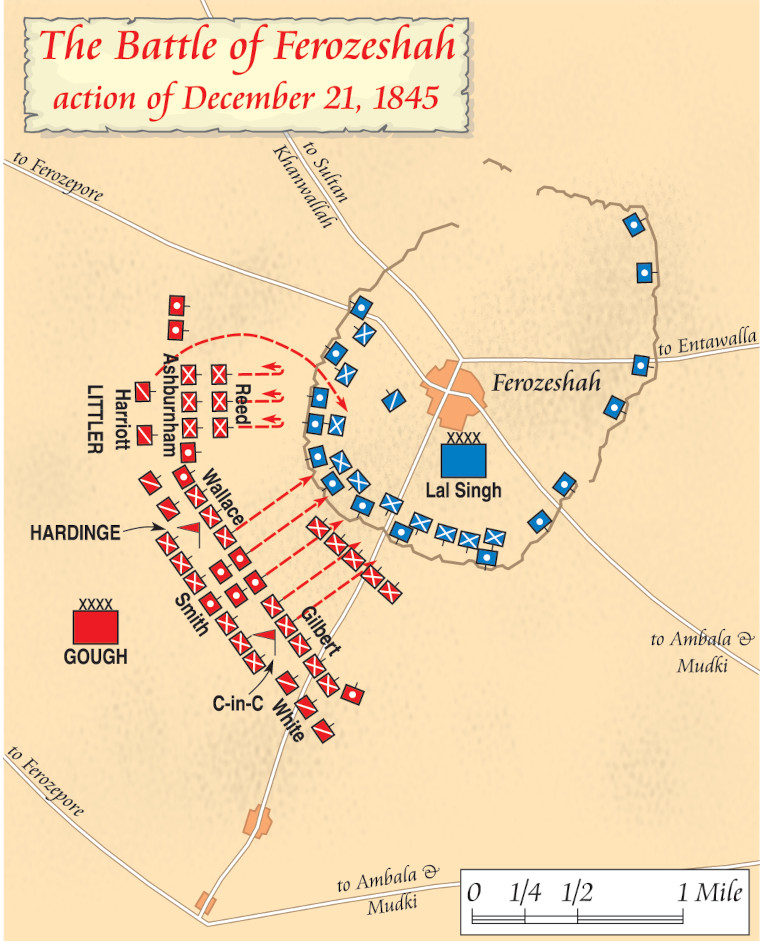
Treachery Within the Khalsa Ranks
The British victory was assisted in large part by the treachery of the two commanders of the Khalsa, Lal Singh and Tej Singh. Before the war began, both had concluded that the Punjab would eventually come under British rule, either by force or by diplomacy, and both wanted to be assured of positions of importance in a dependent Punjab. To this end they were prepared to do all they could to sabotage the Khalsa attack on the British. In fact, Lal Singh let it be known to the British that he had not come over the Sutlej to gain a victory over the British; his object was to solicit their goodwill and continue as prime minister in the Punjab.
When Tej Singh and nearly half of the Khalsa crossed the Sutlej and took up position near Ferozepore with the intention of attacking, Lal Singh refused to cross the river with his part of the Khalsa to reinforce him until he was compelled by his commanders and troops to do so. His intention had been to leave Tej Singh’s force alone in the hope the British would annihilate it. When he did cross, he and Tej Singh urged their troops not to attack Ferozepore, but to move south to take on the main Bengal Army so that “the fame of the Khalsa would be exalted by the capture or death of a governor-general.” The British were secretly assured that although Ferozepore would be an easy victory for the Khalsa, it would not be attacked. Tej Singh maintained his watch on Ferozepore while Lal Singh and a detachment of his force moved south from Ferozeshah to meet the British divisions advancing from Ambala on Mudki.
On the final day of the Battle of Ferozeshah, when Tej Singh and his Khalsa arrived on the battlefield from Ferozepore, he refused to attack the British although urged to do so by his commanders who were sure they could defeat the British. He did little more than send out skirmishers, delaying a full assault until Lal Singh’s forces were driven back and the British and Bengali line had time to reform and range themselves around their colors. And when the British cavalry regiments and horse guns began leaving the battlefield under orders from the deranged Captain Lumley, instead of it being a sign for Tej Singh to attack the remaining enemy troops, it gave him the excuse he needed to stop the attack. He convinced his commanders that the British planned to drive around them to attack them on the flanks and at the rear. Unaware that the exhausted British and Bengali troops were down to their last shot and shell, his subordinates agreed with him. The attack was called off and the Khalsa left the field, making their way back to the Sutlej.
“Another Such Victory and We Are Lost”
British losses were high in the opening battle of the First Sikh War—215 officers and men killed and 655 wounded at Mudki and another 2,415 killed or wounded at Ferozeshah. Khalsa losses were about the same as the British at Mudki, and an estimated 5,000 more fell at Ferozeshah. British officer losses were heavy and included some senior officers, among them Sir Robert Sale, Sir John McCaskill, Brigadier Wallace, and Major George Broadfoot, the political agent. Captain Lumley was medically discharged from the army.
The battle was summed up by a speaker in Parliament, who called it “a high cost for a victory that was not very far removed from failure.” Hardinge shuddered: “Another such victory and we are lost.” The Khalsa and the Bengal Army were left facing each other across the Sutlej, battered and bleeding, while reinforcements and supplies were rushed in for the next battle. Although not decisive, Ferozeshah would prove to be one of the bloodiest battles of the century in the Far East.
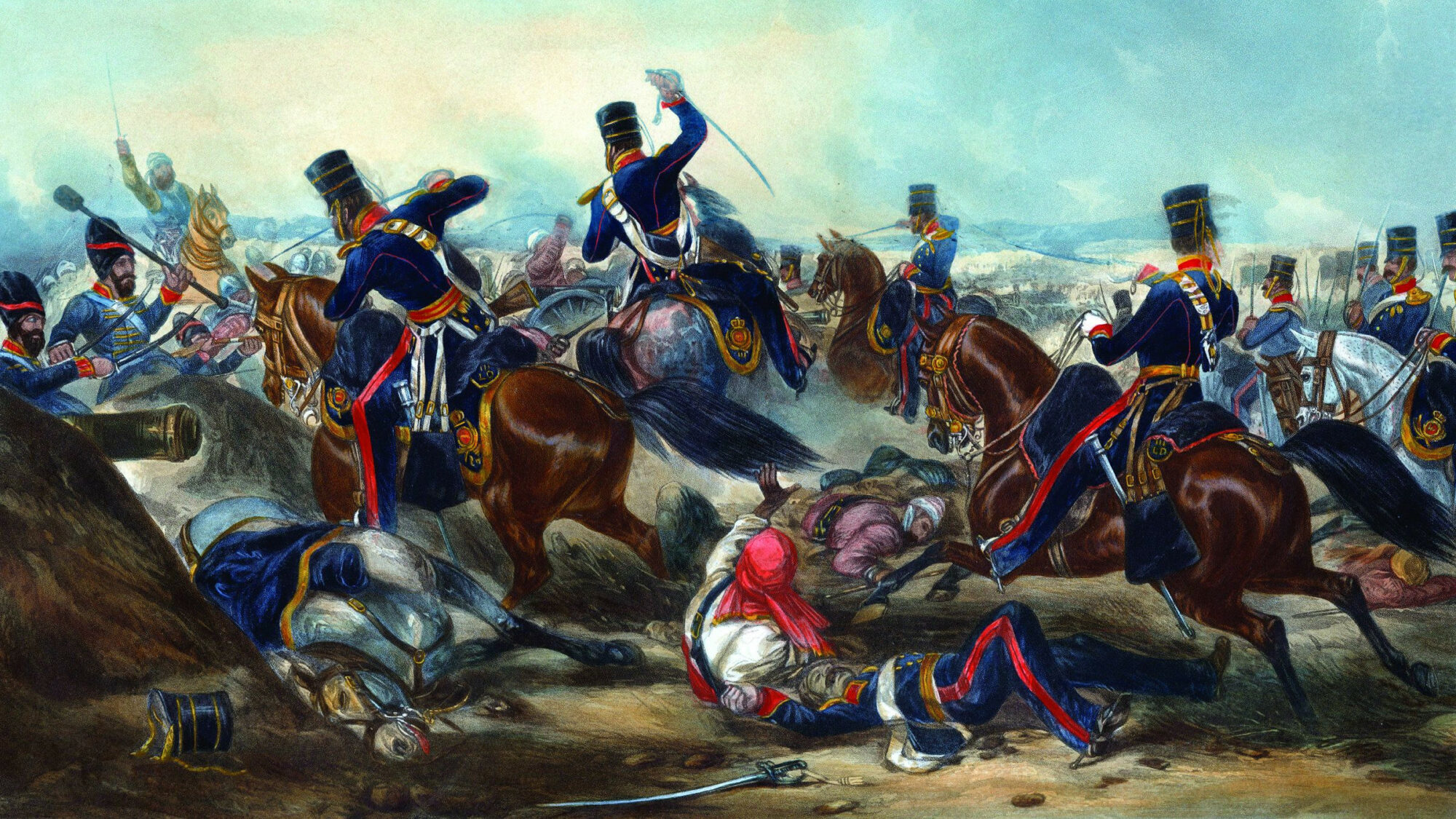
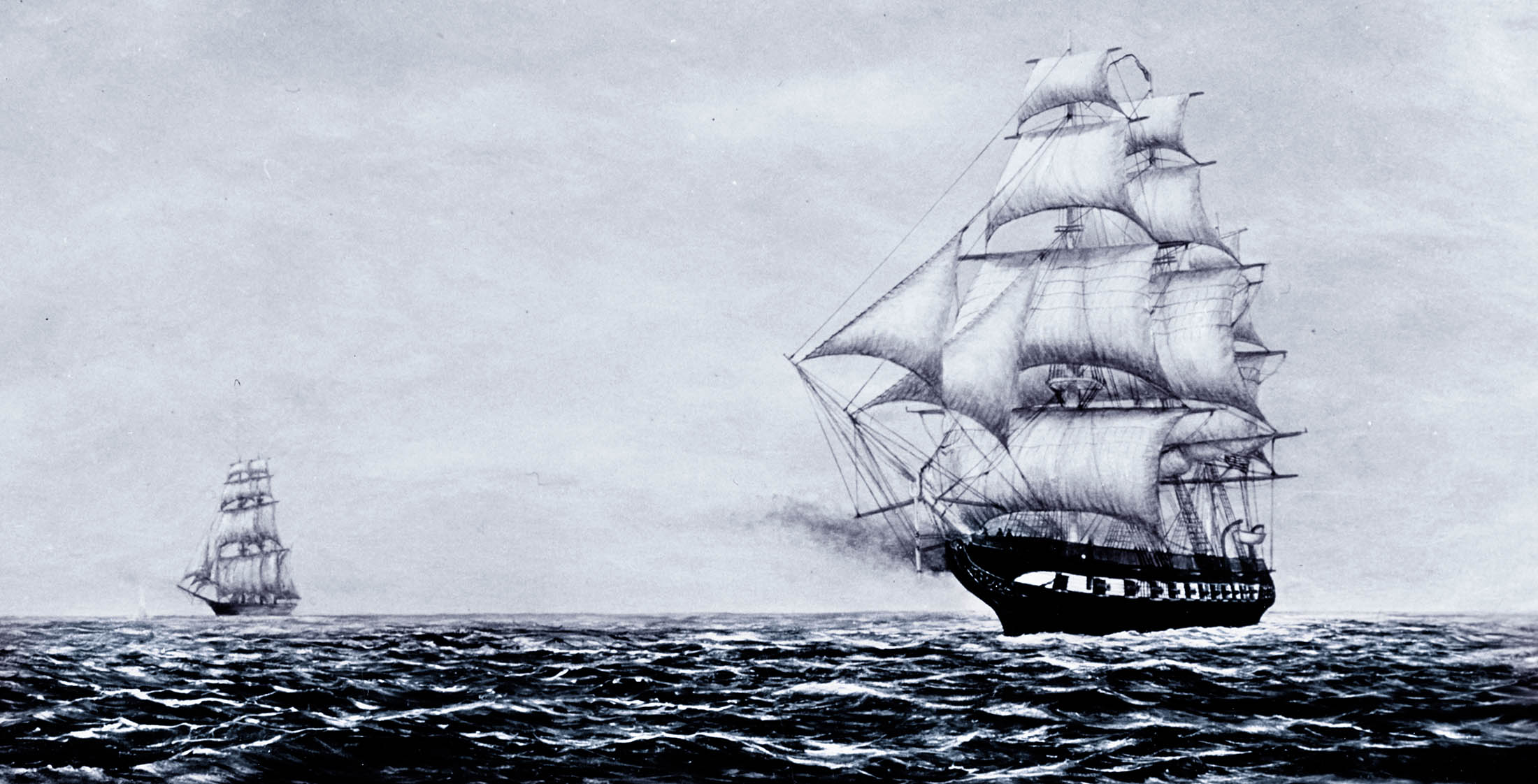
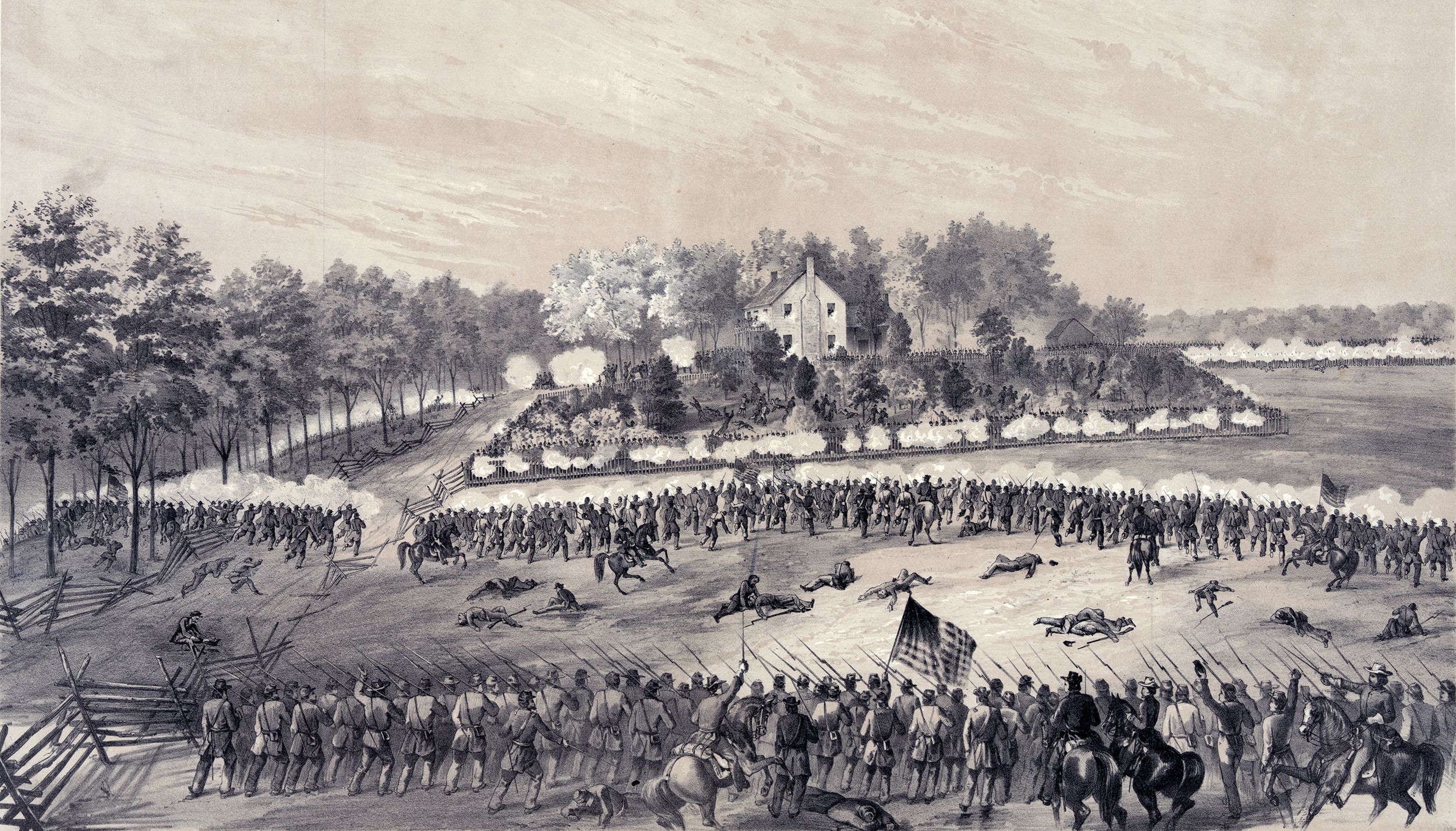
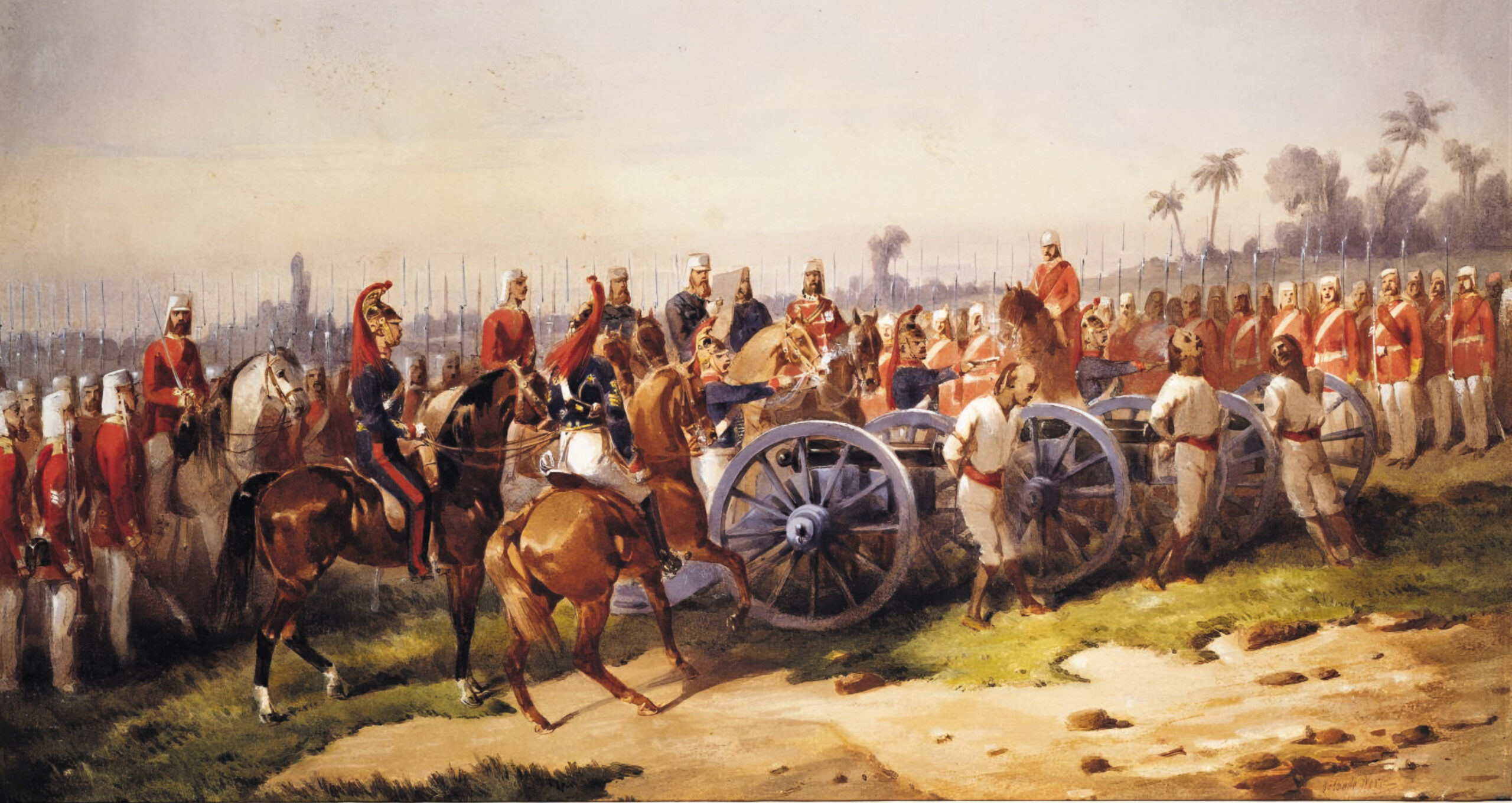
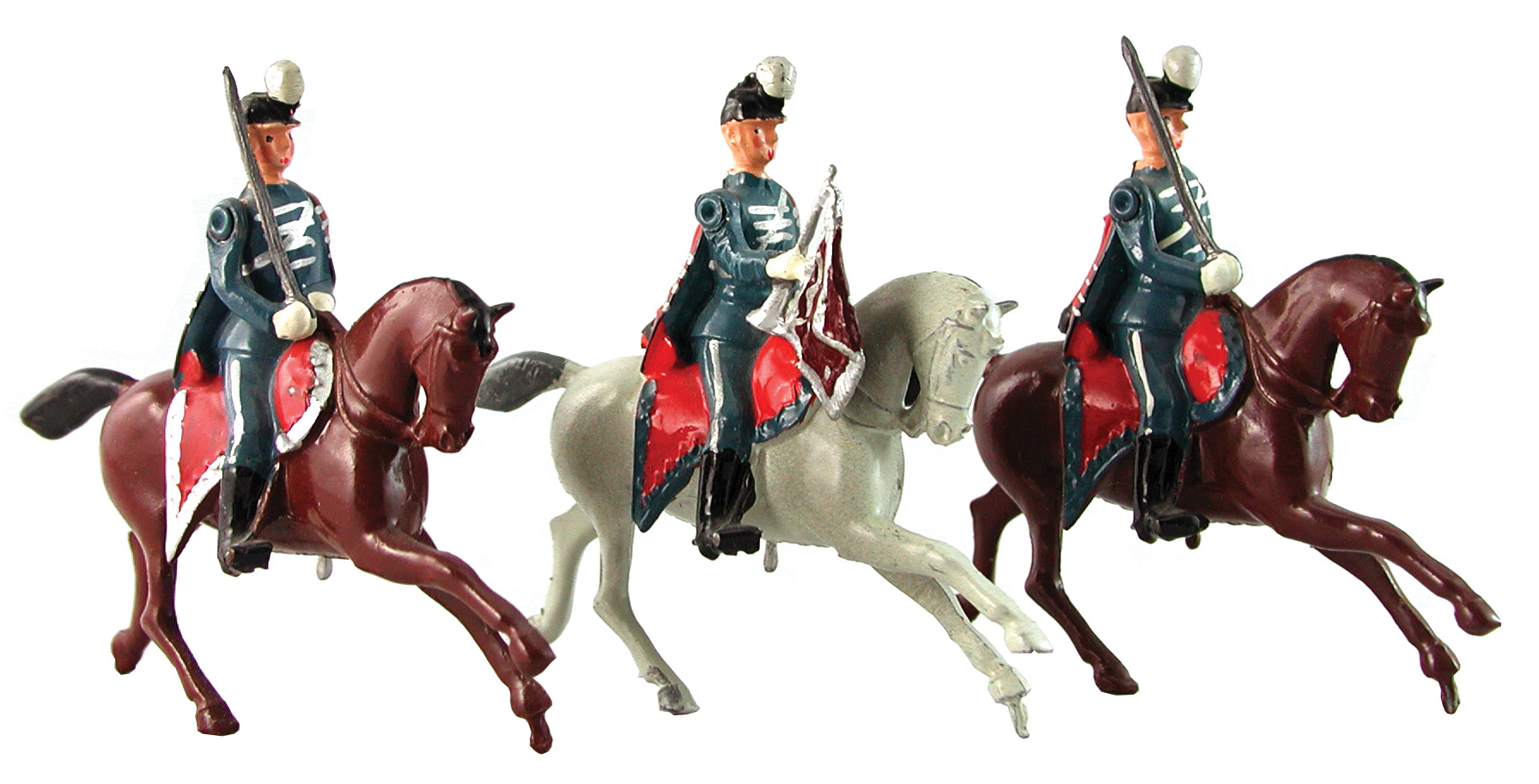
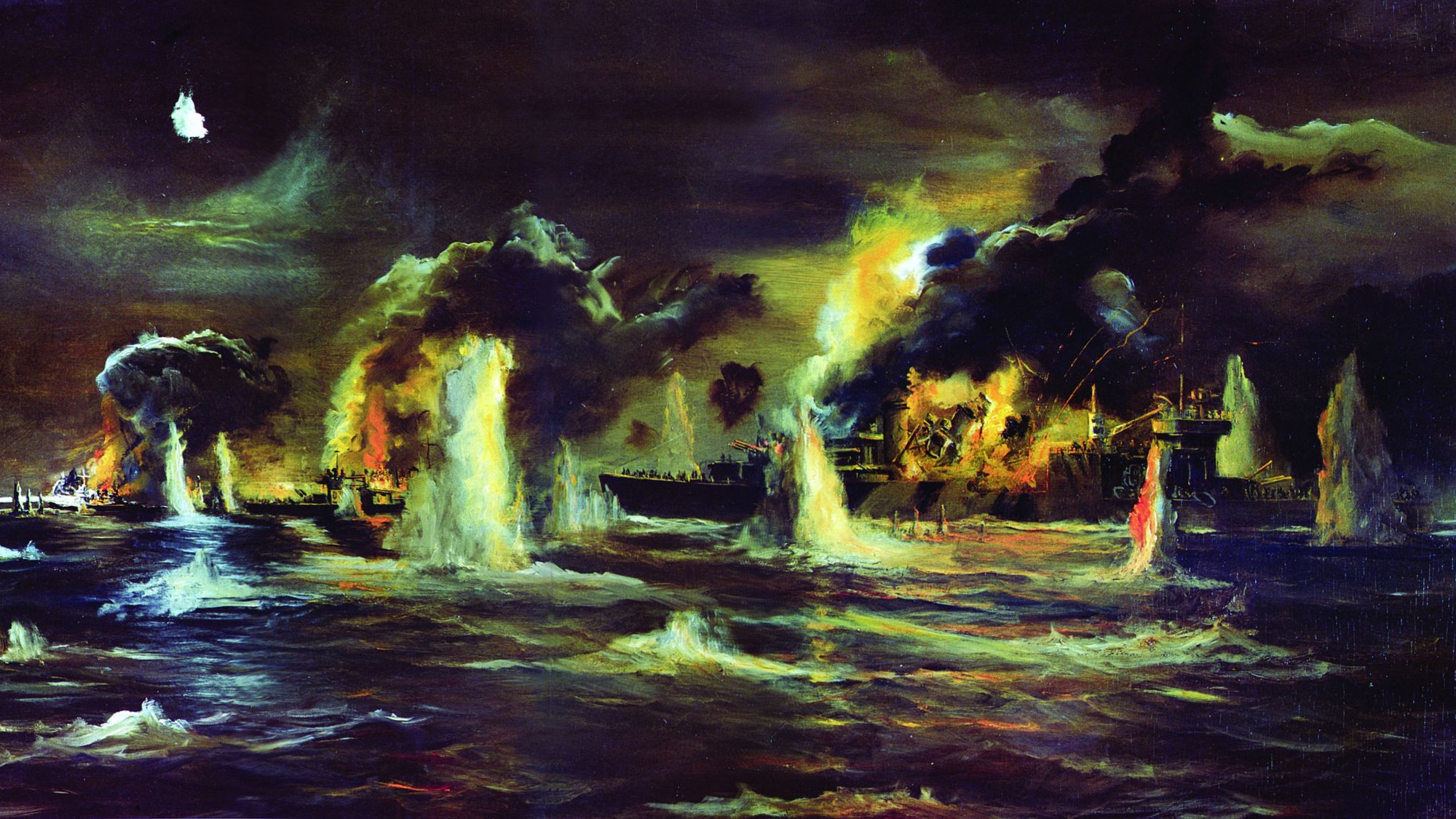
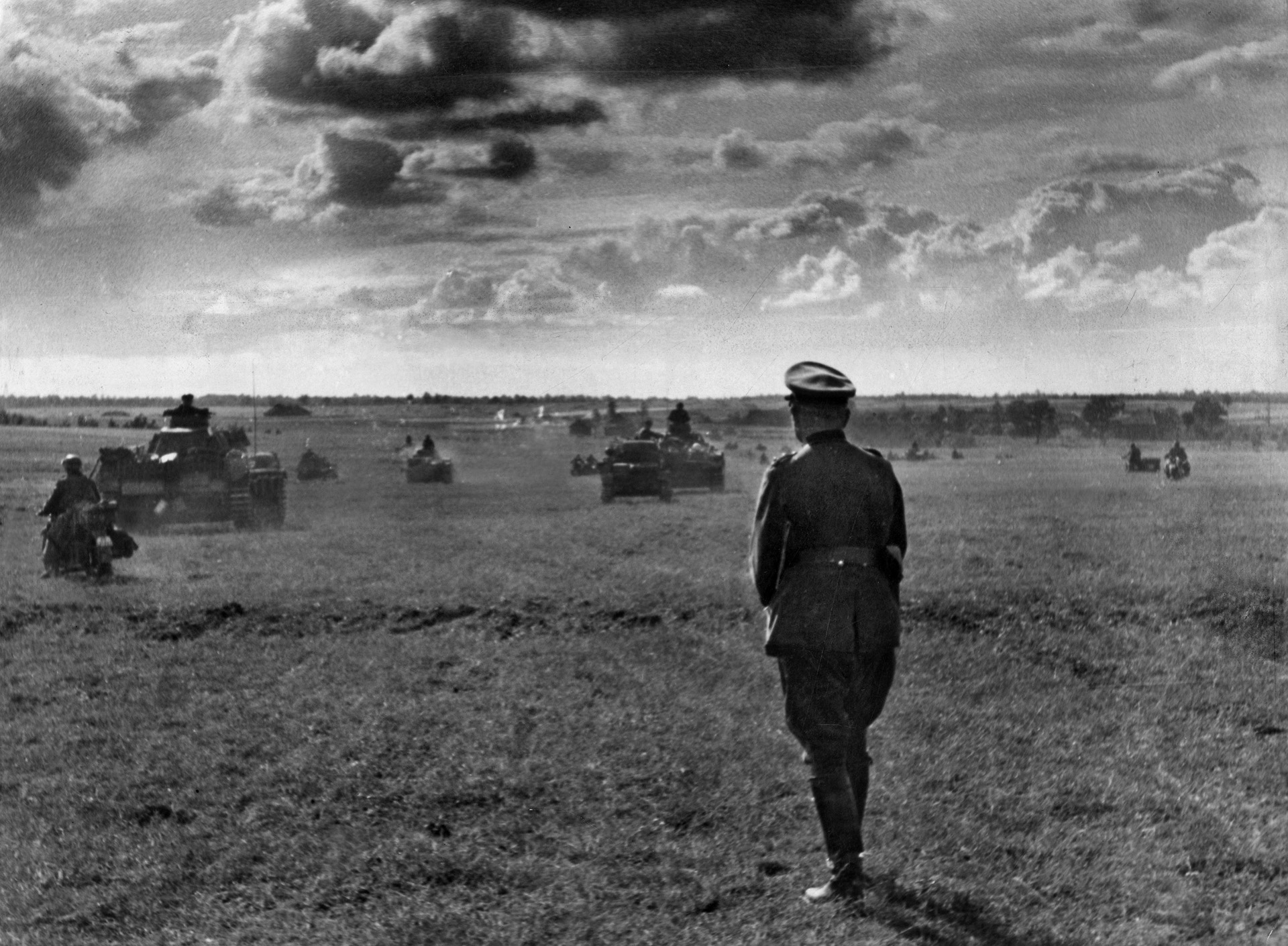
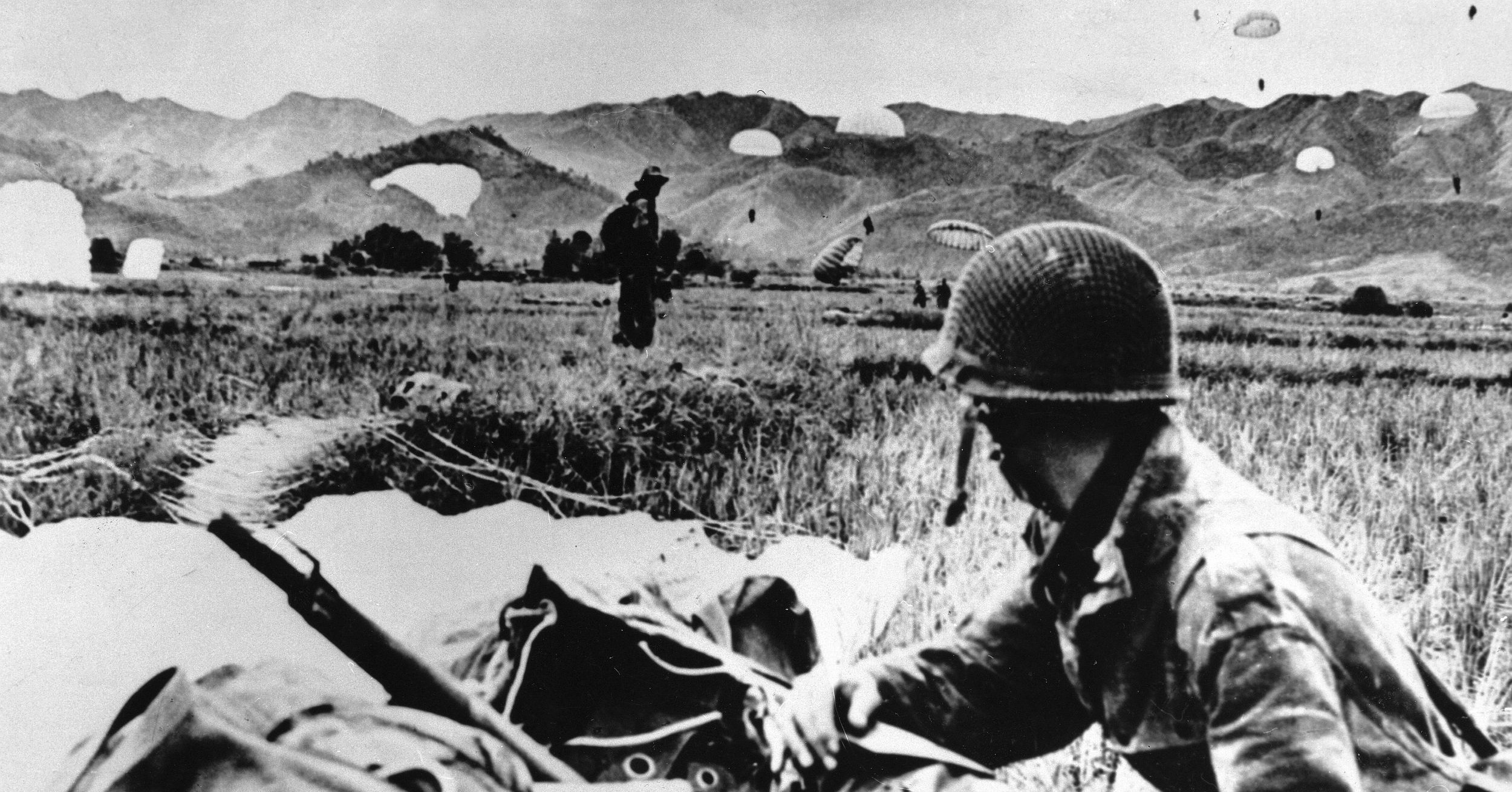
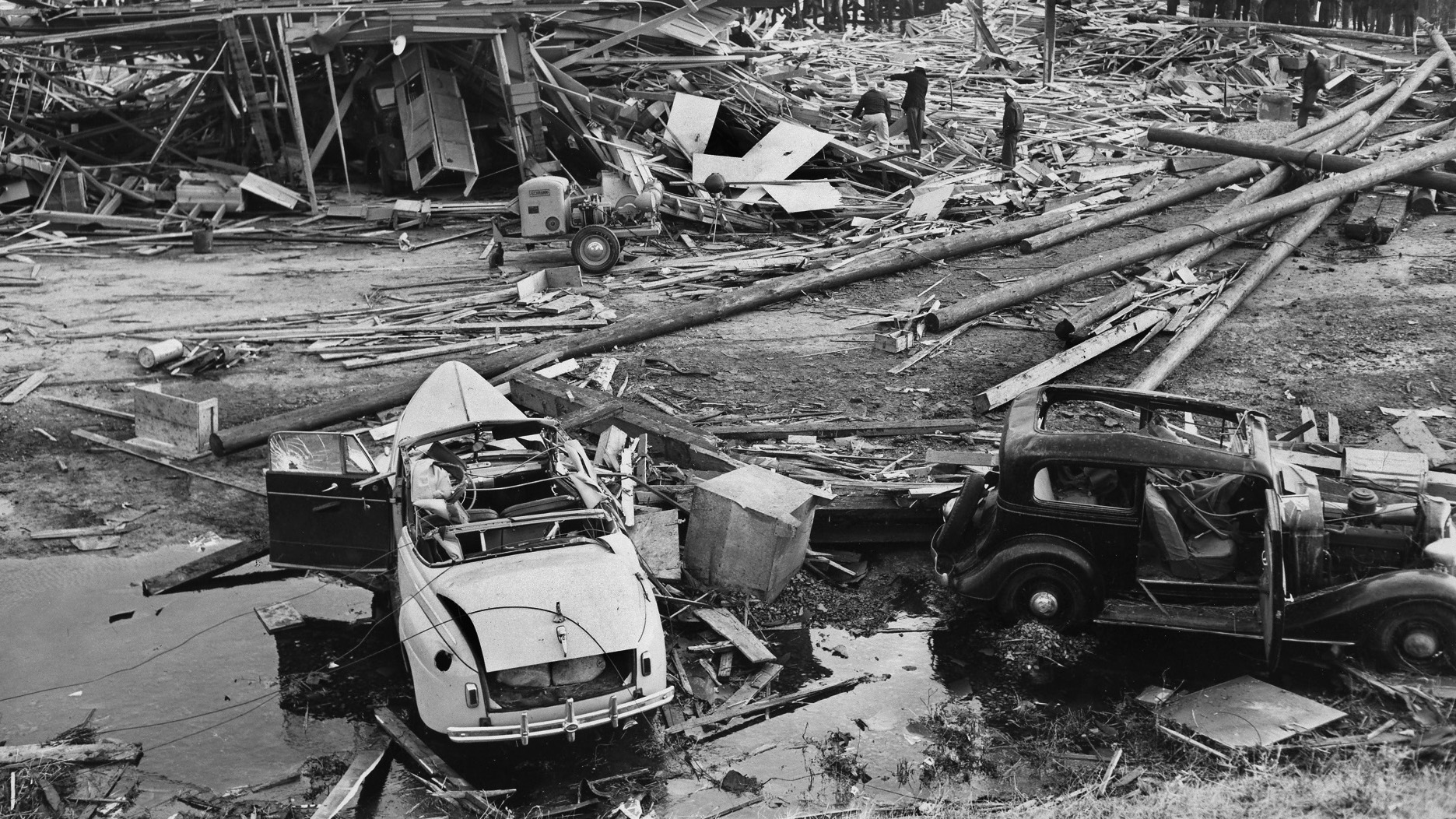
Join The Conversation
Comments
View All Comments